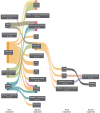Epidemiology, treatment patterns, and associated risk factors in perianal fistulizing Crohn's disease: A systematic literature review
- PMID: 40740890
- PMCID: PMC12305285
- DOI: 10.4240/wjgs.v17.i7.101767
Epidemiology, treatment patterns, and associated risk factors in perianal fistulizing Crohn's disease: A systematic literature review
Abstract
Background: Data regarding complex Crohn's perianal fistulas (CPF) epidemiology are limited, and optimal treatment strategies are elusive. An improved understanding of how CPF treatment options are used in the real-world setting and factors associated with CPF development, treatment failure, and reasons for undergoing multiple surgeries may help to inform optimal patient management strategies, reduce treatment burden, and improve outcomes in patients with CPF.
Aim: To describe the epidemiology, treatments, outcomes, and associated risk/protective factors for complex CPF.
Methods: Electronic databases (MEDLINE, EMBASE, EBM Reviews, EconLit) were searched. Two reviewers independently used populations, interventions, comparators, outcomes, study designs, and time criteria to identify relevant studies. Observational studies published in English from January 1, 2015 to February 17, 2022 with > 50 patients were included, even if complex CPF was not defined. Items of interest included complex CPF definitions, epidemiology, treatment patterns, morbidity, mortality, and risk factors associated with complex CPF development, treatment failure, and undergoing multiple surgeries. Data were reported using descriptive statistics.
Results: Overall, 140 studies were included. Complex CPF definitions were heterogeneous and rarely reported (24 studies). Hence, data mostly related to CPF in general. CPF prevalence was variable (range: 1.5%-81.0%). Incidence was wide-ranging and mostly reported cumulatively at 1-year post-Crohn's disease diagnosis (range: 3.5%-50.1%). Overall healing and failure rates after treatment were in the range of 10.5%-80.2% and 3.6%-83.0%, respectively. Abscesses were the most frequently reported morbidity (n = 18). No CPF-related deaths were reported. No consistent risk or protective factors were identified.
Conclusion: Epidemiology, treatment patterns, and risk factors for CPF vary, likely due to inconsistent CPF and clinical outcome definitions. Standardization would facilitate comparability, which may inform optimal complex CPF treatment strategies.
Keywords: Complex perianal fistula; Crohn’s disease; Epidemiology; Morbidity; Risk factors; Treatment patterns.
©The Author(s) 2025. Published by Baishideng Publishing Group Inc. All rights reserved.
Conflict of interest statement
Conflict-of-interest statement: McKay C was an employee of Takeda at the time of the study and is a shareholder in Merck and Johnson & Johnson. Bolzani A and Kienzle S are employees of Cytel. Cytel’s work was financially supported by Takeda Pharmaceuticals United States, Inc. Geransar P was an employee and shareholder of Takeda Pharmaceuticals at the time of the study. Panés J received consultancy fees/honorarium from AbbVie, Alimentiv, Athos, Atomwise, Boehringer Ingelheim, Celsius, Ferring, Galapagos, Genentech/Roche, GlaxoSmithKline, Janssen, Mirum, Nimbus, Pfizer, Progenity, Prometheus, Protagonist, Revolo, Sanofi, Sorriso, Surrozen, Takeda, and Wasserman and has served on a data safety monitoring board for Alimentiv, Mirum, Sorriso, Sanofi, and Surrozen.
Figures



Similar articles
-
Drugs for preventing postoperative nausea and vomiting in adults after general anaesthesia: a network meta-analysis.Cochrane Database Syst Rev. 2020 Oct 19;10(10):CD012859. doi: 10.1002/14651858.CD012859.pub2. Cochrane Database Syst Rev. 2020. PMID: 33075160 Free PMC article.
-
Falls prevention interventions for community-dwelling older adults: systematic review and meta-analysis of benefits, harms, and patient values and preferences.Syst Rev. 2024 Nov 26;13(1):289. doi: 10.1186/s13643-024-02681-3. Syst Rev. 2024. PMID: 39593159 Free PMC article.
-
Interventions for the management of abdominal pain in Crohn's disease and inflammatory bowel disease.Cochrane Database Syst Rev. 2021 Nov 29;11(11):CD013531. doi: 10.1002/14651858.CD013531.pub2. Cochrane Database Syst Rev. 2021. PMID: 34844288 Free PMC article.
-
Anti-IL-12/23p40 antibodies for induction of remission in Crohn's disease.Cochrane Database Syst Rev. 2015 May 5;(5):CD007572. doi: 10.1002/14651858.CD007572.pub2. Cochrane Database Syst Rev. 2015. Update in: Cochrane Database Syst Rev. 2016 Nov 25;11:CD007572. doi: 10.1002/14651858.CD007572.pub3. PMID: 25942580 Updated.
-
A rapid and systematic review of the clinical effectiveness and cost-effectiveness of topotecan for ovarian cancer.Health Technol Assess. 2001;5(28):1-110. doi: 10.3310/hta5280. Health Technol Assess. 2001. PMID: 11701100
References
-
- Lamb CA, Kennedy NA, Raine T, Hendy PA, Smith PJ, Limdi JK, Hayee B, Lomer MCE, Parkes GC, Selinger C, Barrett KJ, Davies RJ, Bennett C, Gittens S, Dunlop MG, Faiz O, Fraser A, Garrick V, Johnston PD, Parkes M, Sanderson J, Terry H IBD guidelines eDelphi consensus group, Gaya DR, Iqbal TH, Taylor SA, Smith M, Brookes M, Hansen R, Hawthorne AB. British Society of Gastroenterology consensus guidelines on the management of inflammatory bowel disease in adults. Gut. 2019;68:s1–s106. - PMC - PubMed
-
- Gecse KB, Bemelman W, Kamm MA, Stoker J, Khanna R, Ng SC, Panés J, van Assche G, Liu Z, Hart A, Levesque BG, D'Haens G World Gastroenterology Organization, International Organisation for Inflammatory Bowel Diseases IOIBD, European Society of Coloproctology and Robarts Clinical Trials; World Gastroenterology Organization International Organisation for Inflammatory Bowel Diseases IOIBD European Society of Coloproctology and Robarts Clinical Trials. A global consensus on the classification, diagnosis and multidisciplinary treatment of perianal fistulising Crohn's disease. Gut. 2014;63:1381–1392. - PubMed
-
- Ng SC, Plamondon S, Gupta A, Burling D, Kamm MA. Prospective assessment of the effect on quality of life of anti-tumour necrosis factor therapy for perineal Crohn's fistulas. Aliment Pharmacol Ther. 2009;30:757–766. - PubMed
-
- Vermeire S, Van Assche G, Rutgeerts P. Perianal Crohn's disease: classification and clinical evaluation. Dig Liver Dis. 2007;39:959–962. - PubMed
LinkOut - more resources
Full Text Sources

